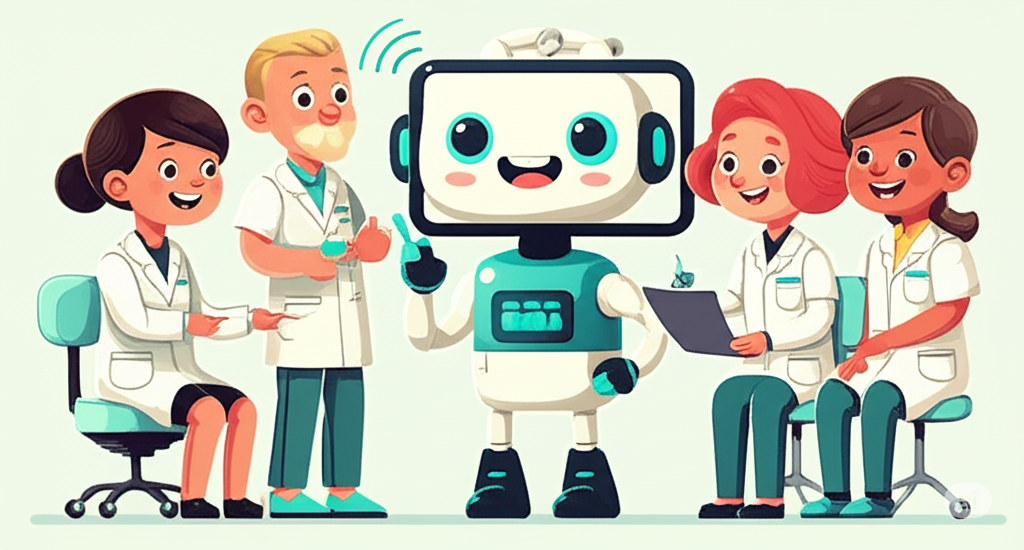

Artificial Intelligence in dentistry is quietly becoming part of everyday dental care—not in a flashy, robot-filled way, but more like a reliable co-worker working quietly in the background. That’s the role of AI Assistants. They’re not here to take centre stage, but rather to keep things running more smoothly behind the scenes.
In the rhythm of a busy clinic day, it’s often the little details that get missed. That’s where AI Assistants quietly step in—not to take over, but to act like a second set of eyes.
This layer of clinical assistance enhances the reliability of the dental process. Dentists can stay focused on patient care while ensuring no important detail is missed in documentation or follow-up.
Behind-the-Scenes Help You Don’t Notice—But Feel
Most patients won’t notice all the background tasks a clinic juggles—booking, billing, reminders. AI Assistants step in here too, taking on the small but crucial tasks.
Smarter Scheduling: AI Assistants can spot booking patterns—like when people are most likely to cancel—and help optimize appointment slots.
Handling Follow-Ups: Routine tasks like confirming appointments or reminding patients about their care are handled automatically.
Scaling Gracefully: As a practice grows, so do its demands. AI Assistants take care of extra admin work without adding strain to the front desk staff.
Freeing Up Time: Less paperwork means staff can focus more on patients instead of chasing forms.
Staying Focused: With fewer distractions, dental teams can give each patient more attention.
Time for Development: With the routine handled, there’s more room for learning or brushing up on skills.
This shift makes patient care not only more efficient but also more personalized and fulfilling for clinicians.
One example making a difference is Diagnocat AI. It helps interpret CBCT scans and turns them into digestible reports.
Dentists don’t have to sift through endless image slices. Instead, they get summaries that speed up treatment planning and make conversations with patients more straightforward.
With tools like Diagnocat, the diagnostic side of dentistry becomes faster and more accessible. That boosts confidence for both clinician and patient.
First impressions matter, and the front desk is where that happens. AI is helping out there too.
Instant Replies: Chatbots can answer common questions immediately—no hold music.
Natural Conversations: If someone asks, “Do you have a morning slot on Friday?” the system understands and responds like a person would.
Always On: Even after hours, VDAs can answer queries and help with bookings.
With a reliable assistant at the digital front door, clinics don’t miss a beat—even after hours.
Voice Tech: Helping Hands-Free
Voice tools are starting to make their way into treatment rooms, allowing dental teams to stay focused and hands-free.

One standout example of a next-generation dental assistant is Navi by scanO. It’s not just smart—it’s tailored to how dental clinics actually work. Navi offers:
The feature provides clinicians with the opportunity to manage scan processes with voice commands, thus reducing interruption during treatment.
Ensures patients and staff from diverse backgrounds feel understood and comfortable.
Handles routine instructions, confirmations, and comfort messages without interrupting care.
Makes the workflow smooth and sterile-free to operate- there is no need to touch the keypad or the screen in the middle of a procedure.
Trains and improves with each and every use adapting to the workflow preferences of any clinic over time.
Clinics using Navi claim their transition between tasks to be easier, the communication more transparent between staff members, and patients to be more involved in the treatment process and obtain a similar knowledge concerning their treatment. This is support with a personality and not necessarily tech-reliant as in the case of Navi.
Not only its features are practically oriented, but fully considerate of both patient and the clinician. Such type of adaptation is the future of AI in dentistry. Navi, which can fit into clinical settings and complement them at the same time, is an interesting case of dental AI becoming increasingly precise and specific.
Dwelling upon the theme of human-centered design, scanO makes sure that AI does not add to the complexity of the clinical routine, but enhances it.
With every update, AI Assistants are getting smarter and more user-friendly. The road ahead looks even more promising.
Custom-Built Solutions: Future AI Assistants will likely be designed just for dental clinics, not repurposed from other industries.
More Human-Like Conversations: As language models improve, these systems will sound even more natural.
Proactive Support: Your AI Assistants might soon suggest follow-ups before you’ve even thought of them.
The future points toward more seamless integration and a stronger partnership between AI tools and clinical teams.
Virtual dental assistants aren’t here to take over. They’re here to support. By handling the repetitive, behind-the-scenes tasks, they give teams more time to focus on patients.
The more we rely on tools like these, the more space we create for human connection. Ironically, that’s what makes modern dental care feel even more personal.
As AI continues to evolve, the best dental experiences will come not from machines replacing people—but from machines helping people do what they do best
scanO is an AI ecosystem transforming oral health for patients, dentists, corporates, and insurers worldwide

© 2025 Trismus Healthcare Technologies Pvt Ltd